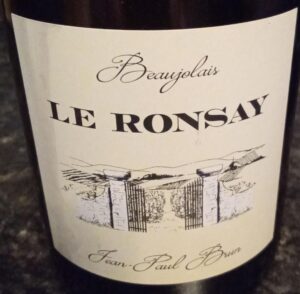“We like Brun’s wines a lot. They are totally devoid of guile, pretense or artifice.”
As I was enjoying this wine a few nights ago, I couldn’t help but recall with some amusement the clique that used to dominate a certain major publication’s wine forums back around the turn of the century. These guys worshiped high-end California Cabs and First Growth Bordeaux. They had more dollars than sense, and were prone to spewing the bloated (not to mention bogus) notion that Gamay is somehow a second-class grape variety not worthy of serious consideration.
Anyone who’s had good Beaujolais, and in particular, the wines of Jean-Paul Brun knows what a ridiculous assertion this is. We’ve had a number of them over the years, ranging from Brun’s Domaine des Terres Dorees Beaujolais l’Ancien Vieilles Vignes to his Morgon and Moulin-à-Vent, and they have never failed to please. The selection reviewed here may be labeled “Beaujolais,” but it drinks like one of the more prestigious crus. As I wrote back in 2009, “We like Brun’s wines a lot. They are totally devoid of guile, pretense or artifice.”
2019 Jean-Paul Brun Domaine des Terres Dorees Le Ronsay Beaujolais, 12% alc., $16.99: A little darker than many Beaujolais, more resembling Pinot Noir than Gamay. Like a big bowl of fruit on the nose, all cherries and berries, red and dark, with a hint of something like rhubarb. Deeper and darker on the palate, with earthy black cherry and blackberry, bigger and more intense than your average Bojo.
Like any good young red, this likes some time in the glass to breathe, getting better and better as it opens. It’s medium-full bodied, and structured for at least a few years of cellaring, but if you give it 30 minutes in a decanter, it drinks quite well already.
From a single vineyard, planted with 20-year old Gamay, this is a traditionally made wine fermented with wild yeast, having none of the bubblegum and banana characteristics that infect too many wines bottled and sold as Beaujolais. A wine of this quality at this price delivers excellent QPR (quality-price ratio), and is highly recommended. I’m getting this at Plum Market in West Bloomfield, but I have seen this in other locations around town for about the same price. Find this wine
Imported by LDM Wines Inc., New York, New York
A pied de cuve is harvested early to kick start fermentation. Grapes are manually sorted then destemmed. A three week maceration takes place in concrete tanks, where the wine also ferments and ages. S02 additions are 1/2 grams per hectoliter after malolactic fermentation and 1/2 grams at bottling.
Reporting from Day-twah,
Bastardo


